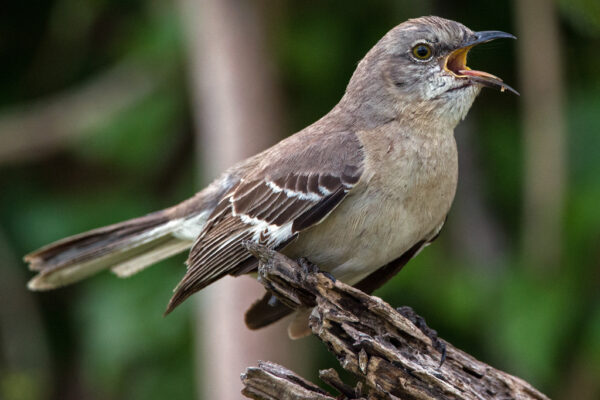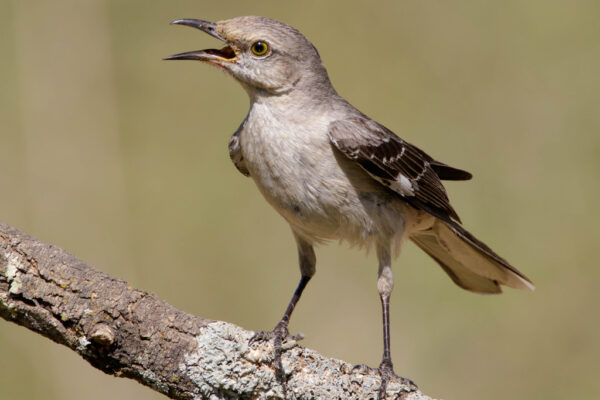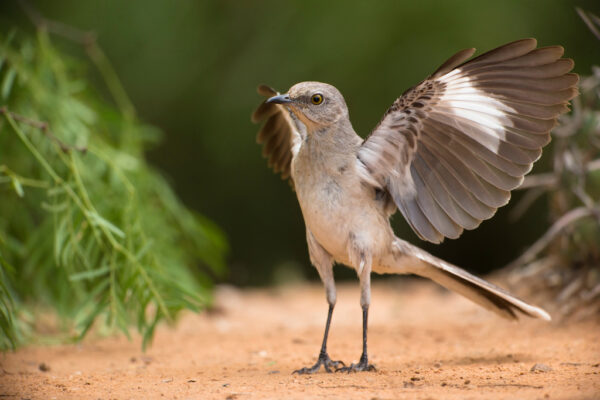THE MELODIOUS MOCKINGBIRD
By Horace Gore
I’ve been around mockingbirds all my life. Yell County, Arkansas, where I lived with my grandmother for six years, from age 6 to 12, had a lot of mockingbirds. Maude Gilmore gave me strict warning about shooting mockingbirds with my slingshot. Every boy I knew at school had a slingshot, and our favorite “ammo” was the glass marbles we used to play with at school.
We played for “keeps” when the teachers weren’t looking. We kept all the marbles we knocked out of the ring with our steel balls. I was a pretty good marble player and kept quite a few glass marbles to use in my slingshot.
Maude made hard rules for my bird shooting: “No mockingbirds, wrens, cardinals (redbirds), and bluebirds.” Sparrows, blackbirds, shrikes, robins, blue jays, and meadowlarks were fair game. My grandmother was especially fond of mockingbirds and cardinals.
When I moved to Hooks—in Bowie County—in East Texas in 1945, we had a lot of birds in that area, including mockingbirds. The same was true with my mother, when I got a .22 single shot for my 12th birthday—no mockingbirds, wrens, red-headed peckerwoods, and cardinals. We had several mockingbirds in the neighborhood, and I knew their nesting habits and the color of their eggs. I watched many young birds leave the nest and go through the first dangerous days of being on the ground, unable to fly. I say all of this, because I was not new to mockingbirds when I moved to the Kokernot Ranch in East Gonzales County.
The ranch house is on a big, flat hill, overlooking the mile-long bottom to the Guadalupe River. The house area includes the pens, the big barn, a small barn and the house. The yard has live oak and cedar elm trees, and there are no other buildings or residences for a mile in any direction.
I first noticed the mockingbird in the spring of 1998. He may have been there before, but I didn’t notice him. What caught my eye about the bird was that his right wing drooped noticeably, and once I noticed him, I saw him around the house all the time. Another unusual thing about this bird—he was a literal virtuoso!
The old ranch house had a tall TV antenna attached to a little storage shed behind the house, which had about three long veins sticking outside of its main pole. The dilapidated antenna was the favorite place for the “mocker” to sit and sing, and I mean SING! I suspected the bird was a male because he sang his heart out each summer for at least five years, and I never ever saw another mockingbird with him or around the house. The ranch house was so isolated that his singing never did get him a mate.
After the first year or two, I began to watch for his arrival each spring. Along about late March or the first days of April, I would hear him singing from his high perch on the TV antenna. He was a regular visitor for at least five years, and maybe more. I would always look for the drooped wing, but I got to know him by his singing habits on the antenna. He never sang anywhere else—just on top of the antenna.
If you’ve ever watched a singing mockingbird, you will have noticed that during his singing, he will suddenly fly straight up for two or three feet and turn a flip in the air—coming back to where he left his perch. The Kokernot Ranch bird did the same thing—up off the antenna and back again, never ceasing to sing.
One summer evening about 5 p.m., I sat in a lawn chair having a cool drink when the old bird came to the antenna and began to sing. I went into the house and got a scrap of paper and pen and came back to my chair. The old bird had been singing all the while. I waited until he mocked a sound that I could remember—the “bobwhite” of a quail. With that, I started counting his songs and making notes.
After a long spell of singing, he came back to the bobwhite call, and I counted the many different calls he had made: 34! I was so amazed that I Googled up the bird, to see if anyone else had counted a mockingbird’s calls during a long singing session. The report noted 35 different calls, so I guess my old bird may have forgotten one.
There has long been debate about mockingbirds. Do they mock other birds, or is their repertoire a natural inheritance? Experts point out the birds repeat the songs of other birds that do not exist in their locale. I think the mockingbird has an inherited vocabulary and doesn’t mock anything.
I enjoyed this mockingbird for about five or six years—then one summer he didn’t come back. He may have decided to change his singing spot, since he had never called in a mate. Or, he may have just died somewhere in his travels—I’ll never know.
All male “mockers” don’t sing like my old bird did. Where there are several birds in one area—both male and female—the male birds hardly ever sing. But when an old bird is all alone on a hill in Gonzales County, perched on a high TV antenna, he will sing his heart out, hoping that some far-away female will hear him and join his company. Woe is the life of a lonely mockingbird.






